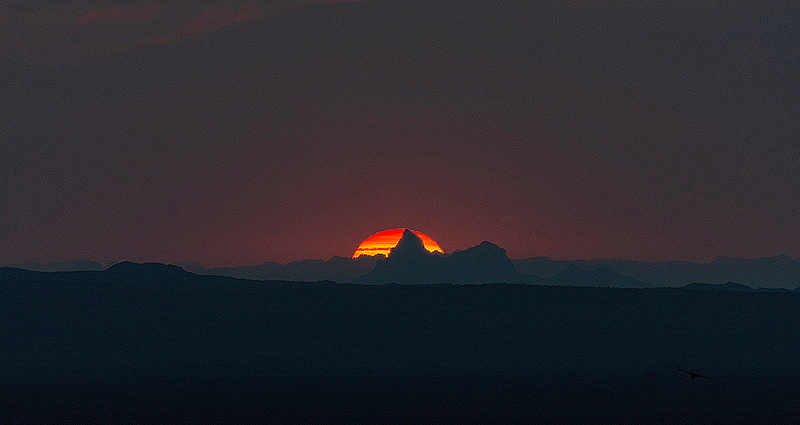Smokey Skies, Sunset & Picacho Peak,
International Space Station
Posted: 18 September 2020
Tuesday, 8 September 2020, dawned with the entire sky grayish-white (no clouds) due to widespread smoke from California wildfires. Horizontal visibility was severely limited. Early Tuesday afternoon clouds and wind from an approaching cold front began arriving. The GEOS-East satellite showed the smoke.

The sky "cleared" on Wednesday, 9 September. Although the clouds left, the sky was still very hazy (smokey) and the wind was still blowing. This webcam photo taken about sunset shows the smokey sky and why I didn't open the observatory.

Thursday morning, 10 September, the sky was clear but with some smoke.

The sky became worse in the afternoon, cancelling my plan to open the observatory that night. This was the view as the Sun was setting.

The smoke from California wildfires covered much of Arizona on Friday, 11 September.

Ninety minutes before sunset the Sun's disk was not visible through the thick smoke from the California wildfires. California's Governor was citing climate change as contributing to the length and seriousness of wildfire season. Maybe California, Oregon, and Washington will finally acknowledge the contribution of Light Pollution on climate change. I know, just wishful thinking. Most elected officials don't get it.
Saturday, 12 September, was still gray but less dense looking. The Sun was barely visible about 50 minutes before sunset.

Sunday, 13 September, had a still smokey but brighter sky until mid-day when clouds appeared beneath the smoke. Monday, 14 September, the sky was less smokey but with some clouds. These webcam images are from 1540 MST and 1820 MST.


Tuesday, 15 September, initially had a nice blue sky, but clouds began appearing mid-day. Smoke increased late afternoon, as seen in these webcam images as sunset approached (left west, right north).


Wednesday, 16 September, began with more visible smoke in the sky that did not improve as sunset approached.

Thursday, 17 September, dawned clear and breezy with very little smoke visible, but some clouds and smoke appeared mid-day. As sunset approached the sky looked better so I went to the observatory.
|
Open: Thursday, 17 September 2020, 1822 MST Temperature: 84°F |
Session: 1518 Conditions: Mostly clear, smokey, breezy |
Equipment:
12" f/8 LX600 w/StarLock
2" 24mm UWA eyepiece
2" 14mm 100° eyepiece
Camera:
D7200 DSLR
iPhone 11 Pro Max
A smoke-reddened Sun was close to setting and looked like it might go directly behind Picacho Peak, 31 miles away. So I quickly moved to a location with a view of the western horizon and took this series of photos (slightly cropped) using a D7200 DSLR with 300mm lens as the Sun set behind Picacho Peak.






1828 MST: sunset.
I returned to the observatory and SYNCed the observatory to WWV time signals.
1838 MST: LX600 ON, StarLock OFF, High Precision OFF.
1840 MST: viewed Jupiter and the four Galilean Moons, 104X. Then viewed Saturn, 102X. Seeing was not great, but the views were nice at times.
1950 MST: I began relaxing on the observatory patio bench. It was nice to once again watch the stars come out.
1859 MST: the breezes were getting stronger.
1932 MST: I began watching the International Space Station (ISS) cross the sky. I took this handheld photo of the ISS over Cassiopeia Observatory using the iPhone 11 Pro Max (Night Mode, 10 seconds, 1X lens). The ISS is the bright streak above the dome, with the constellation of Cassiopeia at the right.

1950 MST: end of Astronomical Twilight. The Andromeda Galaxy (M31) should have been visible to the naked eye, but due to smoke in the sky from the California wildfires it was not visible. The southern sky was very bright as light from Tucson, Oro Valley, and Catalina was reflected off smoke particles. I could not see the center of the Milky Way in the southern sky, but I could see the Milky Way at the Zenith. Obviously observing conditions were not ideal.
I decided to try to observe some bright Deep Sky Objects using 102X. I viewed M13 (Great Globular Cluster in Hercules), M92 (globular cluster), M11 (Wild Duck Cluster, open star cluster), M15 (globular cluster), and M31 (Andromeda Galaxy) and its satellite galaxies M32 and M110. I then viewed M31 and M32 using the 2" 14mm 100° eyepiece (174X).
2012 MST: viewed Saturn and four moons, 174X. Viewed Jupiter, four moons, and the Great Red Spot, 174X. The views were nice during brief moments of relatively good seeing.
2018 MST: LX600 OFF.
2022 MST: took a smoke impacted Sky Quality Reading.
|
Close: Thursday, 17 September 2020, 2033 MST Temperature: 80°F |
Session Length: 2h 11m Conditions: Clear, smokey, breezy, SQM 20.83 |
I recently found my Observing Logs from the 1960s, Comets Alcock (1963b) & Ikeya-Seki (1065F).
I have posted my review of the book The Last Stargazers. If you have wondered what life as a professional astronomer is like, this book is a must read.
On my 31 July 2020 report I briefly mentioned my efforts, began in 2013, to get Congress to fix flawed legislation it created that is putting local lives at risk and harming local businesses. I have now posted a "Congress and the flawed STELA Legislation" blog to document those efforts and my ongoing efforts to work with Congress. If you want to learn more about the Federal legislation that affects several locations in the United States, read my blog.
Comments are welcome using Email. Twitter users can use the button below to tweet this report to their followers. Thanks.
Cassiopeia Observatory Home Page
Copyright ©2020 Michael L. Weasner / mweasner@me.com
URL = http://www.weasner.com/co/Reports/2020/09/18/index.html
